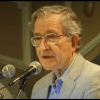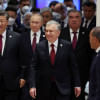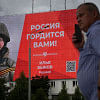The unending cycle of war and peace

Are we moving into an escalating phase towards war? With war returning to Europe with armed conflict in Ukraine, coups in Niger, Central Africa, amidst the hottest July in recorded history, the heating of climate and war is becoming a toxic mix.
The US Director of National Intelligence's 2021 report on Global Trends 2040 gloomily assessed the prospects as follows: "In coming years and decades, the world will face more intense and cascading global challenges ranging from disease to climate change to the disruptions from new technologies and financial crises. These challenges will repeatedly test the resilience and adaptability of communities, states, and the international system, often exceeding the capacity of existing systems and models. This looming disequilibrium between existing and future challenges and the ability of institutions and systems to respond is likely to grow and produce greater contestation at every level."
In short, we have not figured out how to deal with these intermingled poly-crises and reconcile them peacefully. Each trend causes fragmentation as resources and effects are unevenly distributed, requiring hard choices and trade-offs which are not easy to resolve. Ukraine is a moral tragedy, whereby no one wants to take tough decisions for peace, preferring to wage war in which hundreds of thousands have died, millions have migrated and the unspoken outcome is nuclear.
At the heart of global tensions is the refusal of the West to accommodate the interests of the rest, preferring a policy of containment. The recent BRICS summit in New Delhi only accentuated the growing divide between a rich West that is mostly white (except Japan) and the rest. Both sides are enlarging themselves – NATO moving eastwards to the Pacific, whilst BRICS added six new members, Argentina, Ethiopia, Iran, Egypt, Saudi Arabia and UAE. Together, BRICS will account for 29 percent of world GDP and 46.1 percent of world population, versus 51.2 percent of world GDP for NATO plus Japan, which accounts for 13.6 percent of world population. BRICS today also account for 40.8 percent of the world's oil and gas reserves, compared with 13.4 percent / 12.8 percent for NATO/G7. BRICS is also more inclusive, as Ethiopia, Iran, Egypt and UAE are not members of G20.
BRICS is defined by its political and cultural diversity, and more important is not a military alliance. The group represents a poorer but non-white states, many former colonies or would-be colonies, who will not accept a NATO/G7 bunch of aging rich whites still trying to preach democracy and their rules-based order. They know that the Rest has to accept that the West is number one, and any challenger will be considered existential threat, whether it is China, India, Russia or Islam. If G7 truly believes in democracy (one person or state one vote), then the present voting rights in the IMF or World Bank would be dominated by the Rest. No, we can't have that, can we?
The really interesting point is that BRICS members are almost all ex-colonies or countries that historically experienced invasions from NATO members, including Japan. The peace-loving Japan is discharging its Fukushima radio-active water into the Pacific in a gesture of goodwill towards neighbours. If the water is non-radioactive and safe, why don't they simply pump the waters into Japanese soil instead? No one knows what the long-term implications are on marine life in the Pacific.
Small incidents like the Fukushima nuclear waste water hurting a crowded world describes what Austrian Professor Friedrich Glasl considered in his 9-stage Conflict Escalation model. Glasl observed that conflicts arise in all organisations that evolve in three stages with three levels – win-win; win-lose; and lose-lose. In the win-win stage, level one is tension and hardening of views. Level two is debates and disagreements; but level three moves to actions and not just words. In stage two of win-lose for both parties, level four sees each party trying to get into coalitions, seeking allies to bolster their arguments and bargaining positioning. Level five involves action that causes the other side to lose face. Level six then goes into actual strategies and threats, where the other side is seen as opponent, rival or enemy.
Level seven deteriorates into the lose-lose phase, because one side thinks that its limited action will cause the other side to lose more. But this only invites tit-for-tat retaliation. Level eight attacks each other's vital functions until the other fragments, surrenders or collapses. Level nine is nuclear Mutually Assured Destruction, where everyone loses.
Glasl recognises that the Ukraine war is fought at three entangled levels – US versus Russia (global); Russia versus Ukraine (regional); and within Ukraine, Russian-speaking versus non-Russian Ukrainian (local) conflicts. All proxy wars end up with the proxies being totally devastated or crippled. This is not about the pride of Great Powers, but the survival of all.
The Glasl model suggests that escalation can be reversed, provided both sides can find windows of opportunity to de-escalate, moving away from military action to diplomacy. The Ukraine war teaches the fundamental lesson that we must always look at the current situation from the other side's perspective. Ukraine supporters see a violation of sovereignty as the absolute principle that they must defend to the death (many Ukrainians so far). The Russians argue that they are fighting for the existence of Russia as a sovereign state. Westward NATO movement reminds them that Russia was invaded twice in history by Western Europe - Napoleon and then Nazi Germany.
As the last two World Wars demonstrated, wars have an entangled logic of rationality and emotion, with small incidents like the assassination of Austrian Duke Ferdinand leading to rapid mobilization and war. The Second World War was about Nazi Germany seeking revenge from the last defeat. It is easier to enter into war and far more difficult to get out of it. Peace can only come when leaders come to their senses that war can only lead to more war. In today's nuclear age, conventional warfare will inevitably lead to destruction of all. Leaders will have to climb down diplomatically for peace, or face collapse of everything economically, politically and existentially.
There is no victory from nuclear war. Not even a return to the status quo. Which is why peace is the only real option.
Andrew Sheng is a distinguished fellow of Asia Global Institute, University of Hong Kong, and chief adviser to the China Banking Regulatory Commission.
Views in this article are the author's own.
Follow The Daily Star Opinion on Facebook for the latest opinions, commentaries and analyses by experts and professionals. To contribute your article or letter to The Daily Star Opinion, see our guidelines for submission.

 For all latest news, follow The Daily Star's Google News channel.
For all latest news, follow The Daily Star's Google News channel. 










Comments